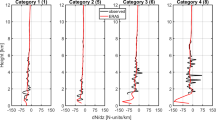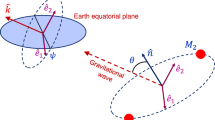Abstract
During the prolonged and deep minimum of solar activity between cycles 23 and 24, an unusual behavior of the heliospheric characteristics and increased intensity of galactic cosmic rays (GCRs) near the Earth’s orbit were observed. The maximum of the current solar cycle 24 is lower than the previous one, and the decline in solar and, therefore, heliospheric activity is expected to continue in the next cycle. In these conditions, it is important for an understanding of the process of GCR modulation in the heliosphere, as well as for applied purposes (evaluation of the radiation safety of planned space flights, etc.), to estimate quantitatively the possible GCR characteristics near the Earth in the upcoming solar minimum (~2019–2020). Our estimation is based on the prediction of the heliospheric characteristics that are important for cosmic ray modulation, as well as on numeric calculations of GCR intensity. Additionally, we consider the distribution of the intensity and other GCR characteristics in the heliosphere and discuss the intercycle variations in the GCR characteristics that are integral for the whole heliosphere (total energy, mean energy, and charge).
Similar content being viewed by others
References
Alania, M.V., Modzelewska, R., and Wawrzynczak, A., Peculiarities of cosmic ray modulation in the solar minimum 23/24, J. Geophys. Res.: Space, 2014, vol. 119, no. 6, pp. 4164–4174. doi 10.1002/2013JA019500
Bisi, M.M., Thompson, B.J., Emery, B.A., et al., The Sun–Earth connection near solar minimum: Placing it into context, Sol. Phys., 2011, vol. 274, nos. 1–2, pp. 1–3.
Cranmer, S.R., Hoeksema, J.T., Kohl, J.L., et al., SOHO-23: Understanding a peculiar solar minimum, Astron. Soc. Pac. Conf. Ser., 2010, vol. 428. CRIS/ACE. http://www.srl.caltech.edu/ACE/CRIS_SIS/cris.html.
Hathaway, D.H., The solar cycle, Living Rev. Sol. Phys., 2015, vol. 12, no. 4, pp. 1–87. doi 10.1007/lrsp-2015-4
IZMIRAN. http://cr0.izmiran.rssi.ru/common/links.htm.
Kalinin, M.S., Bazilevskaya, G.A., Krainev, M.B., Svirzhevsky, N.S., Svirzhevskaya, A.K., and Stozhkov, Yu.I., Description of galactic cosmic ray intensity in the last three solar activity minima, Bull. Russ. Acad. Sci.: Phys., 2015, vol. 79, no. 5, pp. 606–608. doi 10.7868/S0367676515050245
Kalinin, M.S., Bazilevskaya, G.A., Krainev, M.B., Svirzhevsky, N.S., Svirzhevskaya, A.K., and Starodubtsev, S.A., Modulation of galactic cosmic rays in solar cycles 22–24: Analysis and physical interpretation, Geomagn. Aeron. (Engl. Transl.), 2017, vol. 57, no. 5, pp. 549–558.
Kozlov, V.I. and Kozlov, V.V., Cosmic ray fluctuation parameter as indicator of 11-year cycle activity growth phase, J. Phys: Conf. Ser., 2013, vol. 409, no. 1, 012160. doi 10.1088/1742-6596
Kozlov, V.I. and Kozlov, V.V., Aritmiya Solntsa. V kosmicheskikh luchakh (Solar Arrhythmia: Under Cosmic Rays), Yakutsk: IMZ SO RAN, 2016.
Krainev, M.B., Bazilevskaya, G.A., Kalinin, M.S., Svirzhevskaya, A.K., and Svirzhevsky, N.S., Modeling the time and energy behavior of the GCR intensity in the periods of low activity around the last three solar minima, 2014. https://arxiv.org/abs/1411.7526.
Krainev, M.B., The electromagnetic field in and outside the solar wind cavity and the galactic cosmic rays, in Proc. 17th ICRC, Paris, 1981, vol. 3, pp. 357–360.
McComas, D.J., Ebert, R.W., Elliott, H.A., Goldstein, B.E., Gosling, J.T., Schwadron, N.A., and Skou, R.M., Weaker solar wind from the polar coronal holes and the whole Sun, Geophys. Res. Lett., 2008, vol. 35, no. 18, L18103. doi 10.1029/2008GL034896
McDonald, F.B., Cosmic ray modulation in the heliosphere. A phenomenological study, Space Sci. Rev., 1998, vol. 83, nos. 1–2, pp. 33–50.
Mewaldt, R.A., Cosmic rays in the heliosphere: Requirements for future observations, Space Sci. Rev., 2013, vol. 176, nos. 1–2, pp. 365–390. doi 10.1007/s11214-012-9922-0
MSFC. http://solarscience.msfc.nasa.gov/. Omni. http://omniweb.gsfc.nasa.gov/.
Paouris, E., Mavromichalaki, H., Belov, A., Gushchina, R., and Yanke, V., Galactic cosmic ray modulation and the last solar minimum, Sol. Phys., 2012, vol. 280, no. 1, pp. 255–271. doi 10.1007/s11207-012-0051-4
Potgieter, M.S., Cosmic rays in the inner heliosphere: Insights from observations, theory and models, Space Sci. Rev., 2013, vol. 176, nos. 1–4, pp. 165–176. doi 10.1007/s214-011-9750-7
Potgieter, M.S., Vos, E.E., Boezio, M., De Simone, N., Di Felice, V., and Formato, V., Modulation of galactic protons in the heliosphere during the unusual solar minimum of 2006 to 2009, Sol. Phys., 2014, vol. 289, no. 1, pp. 391–406. doi 10.1007/s11207-013-0324-6
Sheeley, N.R., Jr., What’s so peculiar about the cycle 23/24 solar minimum?, in SOHO-23: Understanding a Peculiar Solar Minimum, ASP Conf. Ser., 2010, vol. 428, pp. 3–13.
Stozhkov, Yu.I., Svirzhevsky, N.S., Bazilevskaya, G.A., Svirzhevskaya, A.K., Kvashnin, A.N., Krainev, M.B., Makhmutov, V.S., and Klochkova, T.I., Cosmic ray fluxes in the maximum of absorption curve in the atmosphere and on its boundary, Preprint of Lebedev Physical Institute, Russ. Acad. Sci., Moscow, 2007, no. 14.
Svirzhevsky, N.S., Bazilevskaya, G.A., Kalinin, M.S., Krainev, M.B., Svirzhevskaya, A.K., and Stozhkov, Yu.I., Crossovers of the energy spectra of galactic cosmic rays in the activity minima of consecutive solar cycles, Bull. Russ. Acad. Sci.: Phys., 2017, vol. 81, no. 2, pp. 162–165. doi 10.7868/S0367676517020429
WSO. http://wso.stanford.edu/.
Zhao, L.-L., Qin, G., Zhang, M., and Heber, B., Modulation of galactic cosmic rays during the unusual solar minimum between cycles 23 and 24, J. Geophys. Res.: Space, 2014, vol. 119, no. 3, pp. 1493–1506. doi 10.1002/2013JA01
Zharkova, V.V., Shepherd, S.J., Popova, E., and Zharkov, S.I., Heartbeat of the Sun from principal component analysis and prediction of solar activity on a millenium timescale, Sci. Rep., 2015, vol. 5, 15689. doi 10.1038/srep15689
Author information
Authors and Affiliations
Corresponding author
Additional information
Original Russian Text © M.B. Krainev, G.A. Bazilevskaya, M.S. Kalinin, A.K. Svirzhevskaya, N.S. Svirzhevskii, 2018, published in Geomagnetizm i Aeronomiya, 2018, Vol. 58, No. 2, pp. 177–186.
Rights and permissions
About this article
Cite this article
Krainev, M.B., Bazilevskaya, G.A., Kalinin, M.S. et al. Galactic Cosmic Ray Intensity in the Upcoming Minimum of the Solar Activity Cycle. Geomagn. Aeron. 58, 169–177 (2018). https://doi.org/10.1134/S0016793218020111
Received:
Accepted:
Published:
Issue Date:
DOI: https://doi.org/10.1134/S0016793218020111




